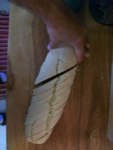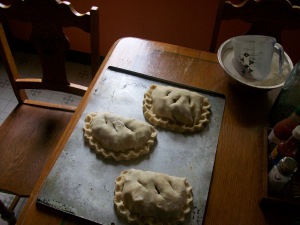You are currently browsing the monthly archive for November 2009.
I grew up pronouncing it pasties (like, past-ease), but I’ve also heard paste-ease. There are many variations, but when you make them and keep it simple, they are wonderfully good. They’re individual pocket pies (probably best known with a meat and potato filling), and we always heard that the Cornish miners always took them to work a century and more ago, down under the earth, wrapped in a newspaper.
Who couldn’t love these moveable feasts, these filling and deliciously simple heritage foods that come to us from ingenious cooks in Wales. The only tricky part sometimes is making a pie pastry – but whether you make it from scratch or use a store-bought pie-crust (I won’t tell if you don’t), it is a very approachable recipe. Thanksgiving (or as one of my Native Elders refers to it: Thanks-taking) is a good opportunity each year to use leftover turkey for these pies. Pasties are traditionally made with beef and potatoes, seasoned simply with salt and pepper, and sometimes they have peas–or carrots and peas. Various cultures have little meat pies in one form or another: samosas, chicken pot pie-even the humble shepherd’s pie could plausibly be considered a distant cousin to this pleasant family of foods. Some little meat pies are baked, others are fried.
The global family of dumplings are also recognizably related also to pasties: Cha Sui Bao (Chinese steamed pork buns), tamales (steamed corn bread with sweet or savory fillings), the famous Tibetan Momo and the Chao-Tze (known best as potstickers), and Kubey Brinj (a tasty little fried torpedo of rice wrapped around a filling of ground meat and onion, deep fried- one of the best things I’ve ever eaten in my life). But let’s return to the redoubtable Pasty.
Make yourself a standard recipe of pastry- you know, 2 cups of flour, 2/3 cup shortening (I generally use a combination of vegetable shortening and butter- and sometimes lard- or even a little beef tallow if I happen to have it in the freezer). A teaspoon of salt, and water to make a workable dough.
Meanwhile for the filling, use a medium chopped onion, about a generous cup of cooked cut-up meat – you could even use a pound of cooked ground beef or turkey, and I think that makes a perfectly wonderful pasty – and a couple of large potatoes, cut into 1/2″ to 1″ cubes (don’t pare them if you don’t have to- most of the vitamin C in a potato is just beneath the fiber rich skin), season with salt and generous pepper to taste – and add frozen peas- and fresh or frozen carrots, also in cubes. That can be a good way to get vegetables in your kids.
When I use the proportions for pie pastry above, I usually divide into 3 portions. Roll a disc of dough out and put about a cup of the meat/potato filling in the center- (I usually assemble the pasties right on an ungreased baking sheet to avoid transferring them around and risking torn dough). Fold the dough over the filling in a half moon shape and crimp the edges with your fingers or a fork. These don’t have to look glamorous- they’re meant to be rustic. Make a few slits on the top of each pasty to allow steam to escape during baking and place in a 350F oven until they’re golden brown and smell very good. (Some people brush them with a little beaten eggs- pretties them up and makes them look fancier). That’s how I learned to make pasties from my mom. We always thought everyone ate these when we were growing up- but pasties are still a new discovery for many people.
If you had turkey, or a turducken or tofurkey on the occasion of a traditional-style Native American Autumn harvest feast, you might have some leftovers: And therefore the ingredients for pasties. Try making them with sweet potatoes in place of white potatoes. Add some corn, or punch up the seasoning with thyme, sage or your favorite herbs. Or try tossing the meat and potato filling with a little leftover gravy to moisten everything. You are the cook and you can make the rules. I’d like to try making a pasty with moose-meat, simply because I love moose! What do you think??




